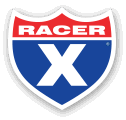Starting this weekend we will see a new color scheme added to the number plates of one bike in particular, the #18 Honda CRF450R of Jett Lawrence. It’s a distinction he earned by claiming the inaugural SuperMotocross World Championship last September. The colors of that championship—purple and yellow—will be on Jett’s bike throughout both SX and MX, unless he’s the points leader. In that case, he will wear red plates with the same yellow numbers. And when Haiden Deegan begins his season, he too will have this unique color on his Star Racing Yamaha. Of course, Lawrence will switch from 18 to #1 when motocross starts, and then both Jett and Haiden will be #1 as they defend their respective SMX titles in September. And if you’re wondering, yes, all of the OEMs agreed to this concept before the AMA made it a rule.
So, for today’s List we thought we would take a look at some of the other number plate changes and trends over the years. In the early AMA years—before 1974—it was pretty much run-what-you-brung, as far as numbers and plates went, and everyone basically wore white plates with black numbers or black plates with white numbers, though riders often turned up with red numbers too.
Once the AMA established three AMA Pro Motocross classes—125, 250 and Open—they began to settle on a system of colors to define which class was which. The 125s would be black backgrounds with white numbers, the 250s would be white plates with black numbers and the Open riders would be yellow plates with black numbers. This was especially helpful in 1984 and ’85, when every national included all three classes.
In 1983 the AMA (and more specifically marketing man Tom Mueller) made a deal with the Wrangler Jeans company to have a Grand National Championship, which would see a rider’s 250SX points (there was no 125 class in SX until 1985) combined with whatever class a rider chose to be in for pro motocross. The ultimate champion—the rider with the most combined points—would be named Grand National Champion and wear #1 the following year, no matter which class he was in outdoors. That led to a weird situation where David Bailey, the ’83 AMA Supercross Champion and 250 Pro Motocross Champion, was awarded #1 in both indoors and outdoors, and given a specific plate with Wrangler’s corporate colors, which was a blue plate with a gold (SX) or white (MX) number 1. The problem was that in ’84 Honda moved Bailey to the Open class, where Yamaha’s Broc Glover was actually the defending champion from 1983. So the AMA let Glover wear his #1 on a Yamaha (white YZ490, yellow plates, black #1) and also Bailey on his Honda (blue plate, gold or white #1, red Honda). And when they added the points up again—SX and MX—Bailey was the GNC #1 again, so he wore the same plate again in 1985, despite the fact that #1 in SX (white plate, black #1) was his teammate, Johnny O’Mara. But that was the last year for the Wrangler deal and that blue plate, at least until the early ‘90s, and a whole new blue plate that was part of the Camel Cigarettes sponsorship. More on that in a minute.
If you come across photos of Johnny O’Mara, Bob Hannah, Ricky Johnson, JMB, and Jeff Stanton, or anyone else from the ‘80s and early ‘90s wearing green plates with white numbers, chances are good it’s from the 250cc USGP or the MXoN—the 250 class wore the green plate with white numbers for years during that time, and the 500s wore those traditional yellow plates with black numbers.
There was also a time when the 125 class, first implemented into AMA Supercross in 1985, had Pro-Am licensed riders wear white plates with red numbers, but that didn’t last long.
The last AMA 500 National Champion was Mike LaRocco in 1993, riding for Team Kawasaki. But LaRocco never got a chance to defend the title because the AMA did away with the 500 class from there on out. LaRocco did get to wear the #1 a single time, as the 500-class entry for Team USA at the ’94 FIM Motocross of Nations in Roggenburg, Switzerland (yes, the one Team USA lost after 13 straight years of winning).
In 1991 the blue plate returned to AMA Supercross when Camel Cigarettes became the title sponsor, and their “Joe Camel” character was blue and yellow. So, 1990 champion Jeff Stanton wore it in ’91, Jean-Michel Bayle in ’92, Stanton again in ’93, and then Jeremy McGrath would wear it as defending champion in ’94. And then Camel went away, and so again did the blue plate. It would return in the mid-‘00s with the WMX, where all of the girls raced with blue plates and white numbers.
In 2000 the AMA switched over to their semi-permanent numbering system that continues to this day. The heartache for the promoters, however, was the fact that Ricky Carmichael did not want to wear #1 when he was champion, preferring his #4. Same thing happened with Chad Reed when he won in 2004 and decided to stick with his #22. So the AMA decided to signify the SX Champion by having them wear a red number plate all times, no matter who the points leader was. AMA Supercross and AMA Pro Motocross were split on this, as outdoors was doing it like they had begun doing in the FIM Motocross World Championship, which is to give the red plate to the points leader, not just the reigning champ. That finally changed in 2009 when Reed, again the series champion, actually wore #1 on his Suzuki RMZ-450. One year later James Stewart did likewise on his San Manuel Yamaha, making the #1 and the red plate kind of redundant.
Finally, it was decided to make the switch to giving the red plate to the points leader in both series, and that’s the way it remains to this day.
And that brings us to today’s unveiling of the new purple plate on Jett Lawrence’s bike, signifying that he’s the SuperMotocross World Champion. The red plate starts the season on the KTM of #1 Chase Sexton, something that the reigning champion starts with for each series. What color plates either Chase or Jett wear next weekend depends on tomorrow night’s results.










